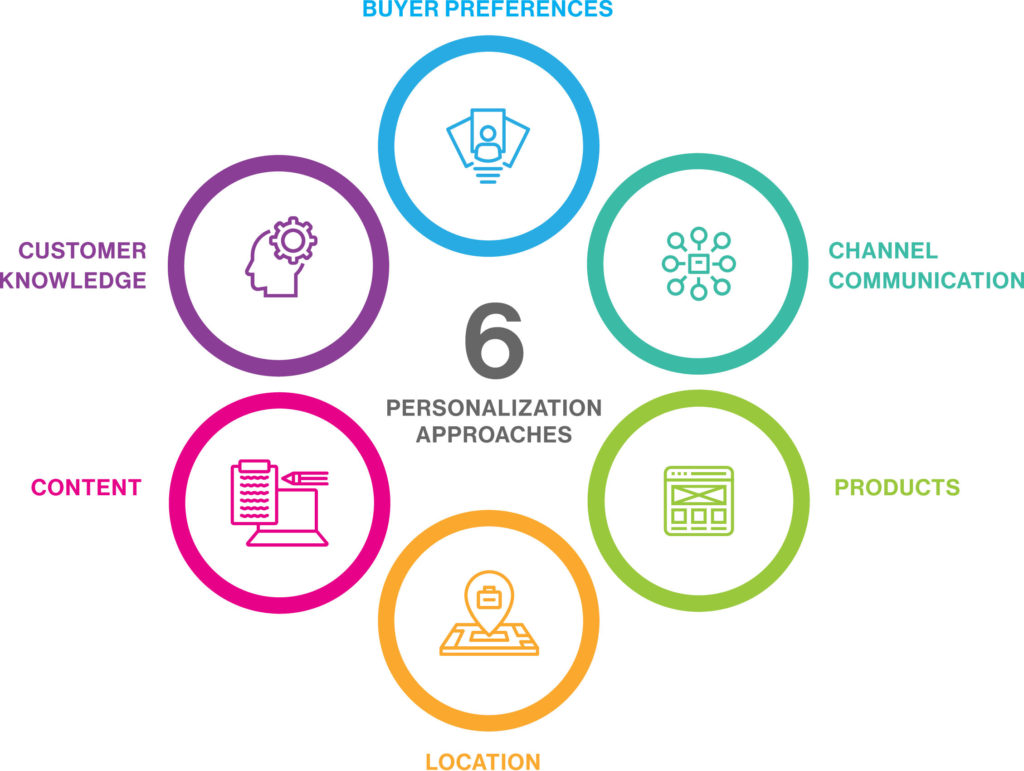6 Personalization Approaches for Your Digital Strategy
- 5 minutes read
In today’s uber-competitive digital environment, buyers, and particularly millennial buyers, have come to expect some level of personalization in their website interactions.

While the fine line between personalization and privacy is constantly being (re)defined, the following are clear: Some level of personalization is accepted, if not expected, by today’s online community; Personalization is an effective way to increase sales; And personalization is a key differentiator in customer retention. With these truths in mind, let us look at six different personalization approaches to consider as you develop your digital strategy.
Buyer Preferences Approach
The first personalization approach is buyer preferences. This is a relatively simple approach in which you solicit information directly from the customer and apply these preferences to their digital experience. This may include your preference for an aisle seat or window seat when you travel, your preferred shipping and/or payment methods, etc. Users are very familiar and at ease with these approaches, to the point that they are expected as part of any customer account.
Channel and Communication Approach
The second approach is channel and communication. Like the buyer preferences approach, this also incorporates data provided by the customer, but it focuses on both when and how the customer prefers to be notified. For example, a customer may wish to be notified about order updates. You may allow the customer to choose to be notified only when certain types of order updates occur (e.g. backorder). You may give the customer the option to choose which communication channels to use for the notifications, such as email, text, phone call, etc. Of course, the customer may prefer different channels for different types of communications, since a credit card charge event may be more important to the customer than an order shipped event.
Products Approach
The third approach is about the products and the relationships between them. At this level you, the merchant, begin to take the lead, and so this approach requires more effort on your part. The classic example of this approach is grouping together products that typically are purchased together (e.g. a child’s toy and batteries, or a software package and support). This approach can be simple, as in the previous example, or highly complex. Some companies are developing highly complex algorithms or artificial intelligence to build complex models or identify relationships that aren’t necessarily obvious. For instance, a grocery chain that identifies a correlation between candles and severe weather events, or a hardware store that recommends medical supplies along with a heavy ceiling fixture because they learned that many customers were getting injured trying to install the fixture.

Location Approach
The fourth approach involves location. With this approach, you use the customer’s location to enhance the user experience. The classic example of this is the recommendation of stores/restaurants based on your location. But many stores also use this approach in their mobile apps to help you find items in their store, leading you directly to the aisle and shelf location where your desired item is located.
Content Approach
The fifth approach focuses on content. This brings a step up in the complexity ladder, as this approach requires that you understand the characteristics of an individual customer that may not be explicitly offered by the customer themself and/or may not be readily available via technology (e.g. location). At this level, you will generally start pulling in data from a wider variety of sources, some internal and some external, and you may start to look for indirect relationships between various “attributes” towards which the customer exhibits tendencies. Based on all of this data, you can begin suggesting content and/or products that the customer may not have otherwise considered.
Customer Knowledge Approach
The sixth and final approach is customer knowledge. This might be termed the “Holy Grail” of personalization, and rightfully so. It is the culmination of all the other approaches at a very high level of robustness. Here you begin to develop a 360-degree perspective of the customer, pulling in data from many sources, including complex machine learning and/or AI technologies. Only a small percentage of digital platforms ever reach this high level of maturity of personalization, given the effort, cost, and technology required to achieve it.
Now that we’ve discussed the personalization approaches, it is important to understand that these personalization approaches are not independent of one another, nor are they totally dependent upon one another. You will need to determine which of them you want to apply; or, more importantly, which of them you reasonably can apply given your particular products/services and digital maturity model. And this, truly, is where the challenge lies.
Rich digital experiences have significantly raised your customers’ expectations. Create relevant, individualized interactions with your customers that secure long-term relationships.
CoStrategix can help with digital commerce, subscription commerce, and personalization strategies that use AI-driven, machine learning-based approaches integrating with your product platforms to drive up-sell and cross-sell recommendations. We’d love to chat with you.
AI Strategy & Solutions – Elevate your business with advanced analytics
Data & Insights – Drive insights that lead to competitive advantage
Product Development – Build platforms that power unique digital capabilities
Platform & Technology Modernization – Modernize for stellar experiences, efficiency, and AI
Related Blog Posts
Building Usability and Accessibility into Digital Products
October 16, 2024
The Future of SSRS, SSIS, and Microsoft Fabric
September 20, 2024
Considerations for Moving to Microsoft Fabric
August 15, 2024







